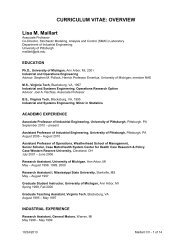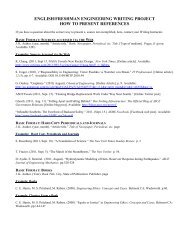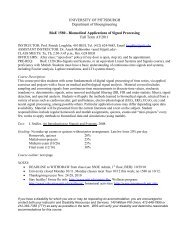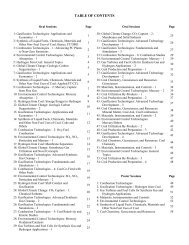Development of Gasification and Activities in Turkish Coal Enterprises
Development of Gasification and Activities in Turkish Coal Enterprises
Development of Gasification and Activities in Turkish Coal Enterprises
Create successful ePaper yourself
Turn your PDF publications into a flip-book with our unique Google optimized e-Paper software.
<strong>Development</strong> <strong>of</strong> <strong>Gasification</strong> <strong>and</strong><strong>Activities</strong> <strong>in</strong> <strong>Turkish</strong> <strong>Coal</strong> <strong>Enterprises</strong>Mustafa ZIYPAKHead <strong>of</strong> The Research <strong>and</strong> <strong>Development</strong> DepartmentThe 28 th Annual International Pittsburgh <strong>Coal</strong> Conference, September 12 - 15, 2011, Pittsburgh, PA
ENERGY DATA OF TURKEY• Turkey is not very rich <strong>in</strong> terms <strong>of</strong> energyresources, therefore it is dependent onoutside on a large scale• Dependency rate <strong>of</strong> energy changesbetween %70-75• Energy import for 2010 is 38,5 billiondolars, for 2011 estimated between 45-50billion dolars• Turkey’s current deficit is largely due toenergy import• 2010 Electricity consumption <strong>of</strong> Turkey is210.182.000.000 kwh• Annual <strong>in</strong>crease rate <strong>in</strong> electrictyconsumption is between %6-8
COAL DATA OF TURKEY• <strong>Coal</strong> is one <strong>of</strong> the most importantenergy sources <strong>of</strong> Turkey.• It has 12,4 billion tons <strong>of</strong> lignite <strong>and</strong> 1,3billion tons <strong>of</strong> hard coal depositDistribution <strong>of</strong> Average CalorificValues <strong>of</strong> <strong>Turkish</strong> Lignites• 85 million tons <strong>of</strong> lignite <strong>and</strong> 2,5 milliontons <strong>of</strong> hard coal are produced annually• Additionally 20 million bitum<strong>in</strong>uouscoal is imported every year.• 1/4’th <strong>of</strong> all coal is utilized for electricityproduction, rema<strong>in</strong><strong>in</strong>g is used for<strong>in</strong>dustry <strong>and</strong> heat<strong>in</strong>g purposes• <strong>Turkish</strong> lignites are generally low gradecoals
TURKISH COAL ENTERPRISES (TKI)• TKI, which was established <strong>in</strong> 1957, a State-Owned Economic <strong>Enterprises</strong>,• TKI which carries out lignite production is among lead<strong>in</strong>g m<strong>in</strong><strong>in</strong>g companies <strong>in</strong>Turkey• Approximately 8200 personel have been employed• For 2009 annual <strong>in</strong>come is 1,5 billion dollars, pr<strong>of</strong>it 280 million dollars• For 2010 annual <strong>in</strong>come is 1,45 billion dollar, pr<strong>of</strong>it 230 million dollars• In rank<strong>in</strong>g <strong>of</strong> first 500 companies <strong>in</strong> Turkey, TKI is 16th for 2008, 18th for 2009• Annual production <strong>of</strong> TKI changes between 35-40 million tons• TKI has 2,6 billion tons <strong>of</strong> lignite deposit that consists <strong>of</strong> 21% <strong>of</strong> Turkey’s totallignite• In fact, TKI owns important lignite sites <strong>and</strong> they are comparatively high gradecoals• TKI fulfills coal requirement <strong>of</strong> total 4250 MW thermal power plants.
WHY AND WHAT RESEARCH AND DEVELOPMENT?Due to; low rank <strong>of</strong> coal (low calorific value, high ash, humidity, sulfur etc.) be<strong>in</strong>g one <strong>of</strong> the most important energy sources <strong>of</strong> Turkey dependency <strong>of</strong> Turkey to other countries on energy sources sign<strong>in</strong>g <strong>of</strong> Kyoto Protocol by <strong>Turkish</strong> Government (some sanctions may be the case<strong>in</strong> com<strong>in</strong>g years) need to <strong>in</strong>crease productivity <strong>and</strong> value-added by advanced technology.TKI have been perform<strong>in</strong>g research <strong>and</strong> development activities for 5 yearsR&D activities are ma<strong>in</strong>ly comprised <strong>of</strong>; coal preparation <strong>and</strong> enrichment gasification, related <strong>of</strong> which gas clean<strong>in</strong>g, gas condition<strong>in</strong>g <strong>and</strong> separation, fuel<strong>and</strong> methanol production coal m<strong>in</strong><strong>in</strong>g <strong>and</strong> coal exploration coal-derived products (e.g. Humic acid)
TKI’S R&D PROJECTS RELATING TO GASIFICATIONTKI’s gasification R&D Projects can be grouped <strong>in</strong>to three categories1. Conventional <strong>Gasification</strong> Projects1.1 TKI Pilot <strong>Gasification</strong> Projects1.2 T Liquid Fuel Production From Biomass <strong>and</strong> coal blend - Trijen Project1.3 Feasibility study for <strong>Turkish</strong> Lignites gasification (USTDA supported)2. Underground <strong>Gasification</strong> Projects2.1 Research <strong>and</strong> analysis <strong>of</strong> underground coal gasify<strong>in</strong>g <strong>in</strong> thelaboratory environment2.2 Underground <strong>Coal</strong> <strong>Gasification</strong> Analysis for <strong>Turkish</strong> <strong>Coal</strong> <strong>Enterprises</strong>3. Advanced <strong>Gasification</strong> R&D Projects3.1 <strong>Coal</strong> <strong>Gasification</strong> via Plasma Application3.2 Methane Production by <strong>Coal</strong> Biotechnology
TKI COAL GASIFICATION PROJECTS(Selection <strong>of</strong> types <strong>and</strong> capacities <strong>of</strong> gasifiers)<strong>Coal</strong> typeGra<strong>in</strong> size<strong>Gasification</strong>time<strong>Gasification</strong>mediumExit GastempratureFixedbedNoncak<strong>in</strong>gFluidizedbedNoncak<strong>in</strong>gEntra<strong>in</strong>edbedAll types5-50 mm 0,5-5 mm 0-0,5 mm15-20m<strong>in</strong>.Air/oxygen/steam400-500o C0,5-1,5hourAir/oxygen/steam700-900o C
A PICTURE FROM 250 t/h ENTRAINED BED GASIFIER
DESCRIPTION OF 250 t/h ENTRAINED BED GASIFIER250 t/h Entra<strong>in</strong>ed <strong>Gasification</strong> plant consist<strong>of</strong> 5 units:1.<strong>Coal</strong> Preparation UnitCapacity <strong>of</strong> the Unit is 1 ton/h- 0-40mm orig<strong>in</strong>al coal with max.30% humidity is crushed by a hammercrusher to 10 mm- Then is fed to a gr<strong>in</strong>der <strong>and</strong> ground to100 µ- Humidity <strong>of</strong> ground coal is decreased to5%- The hot gas for dry<strong>in</strong>g is produced fromlight oil- The dried <strong>and</strong> ground coal istransported to gasification unit undernitrogen pressure (denseveyor)2. Oxygen <strong>and</strong> nitrogen tanks- Oxygen <strong>and</strong> nitrogen requirements <strong>of</strong>gasifier will be met from 2 tanks, each willhave a capacity <strong>of</strong> 10 tons- There will be heat exchangers <strong>in</strong> theexit <strong>of</strong> the tanks- Nitrogen pressure is adjusted between0,5-1,5 bar, oxygen pressure is fixed as0,5 bar3. Preparation <strong>of</strong> cool<strong>in</strong>g <strong>and</strong> boiler feed water- Water is cleaned via s<strong>and</strong> filter, cation<strong>and</strong> anion exchangers- Water need <strong>of</strong> the system is 2000 lt/h- There is a 10 m³ tank for processed water
UNITS OF 250 t/h ENTRAINED BED GASIFIERS (2)4. Gasifier Unit• Gasifier works under atmosphericpressure, gasify<strong>in</strong>g temperature is 1500 °C• Gasifier <strong>in</strong>cludes coal lock, coal screw, ashlock, quench section• Gasifier <strong>and</strong> quench section are l<strong>in</strong>ed withrefractory. These sections are not jacketedto produce steam• Oxygen <strong>and</strong> nitrogen is fed to gasifier at0,5 bar <strong>and</strong> 1.5 bar respectively• Part <strong>of</strong> the molten ash leaves the gasifierto scrubber <strong>and</strong> rema<strong>in</strong><strong>in</strong>g falls tounderwater scrapper• Gas is cooled to 950 °C at quench sectionby spray<strong>in</strong>g water <strong>and</strong> leaves waste heatboiler at 300 °C5. Water Clarify<strong>in</strong>g <strong>and</strong> Ash Stock<strong>in</strong>g• Dirty water is clarified by add<strong>in</strong>g Al₂SO₄• Then water is pumped to clean watertank <strong>and</strong> cool<strong>in</strong>g tower• Ash gets rid <strong>of</strong> sticky feature by cool<strong>in</strong>gat quench section <strong>and</strong> drops ashremov<strong>in</strong>g system• Ash is transferred to conveyor belt bymeans <strong>of</strong> palette on ash remov<strong>in</strong>gsystem <strong>and</strong> the conveyor carries ash<strong>in</strong>to ash pool
GASIFICATION DATA FOR 250 t/h ENTRAINED GASIFIERCharacteristics <strong>of</strong> the prepared coal forthe gasifier- Carbon….: 59,92%- Hydrogen: 4,25%- Nitrogen..: 2,08%- Sulfur…….: 1,97%- Oxygen….: 8,74%- Ash………..: 18,05%- Moisture.: 5,00%Accord<strong>in</strong>g to results <strong>of</strong> gasifier design,used materials <strong>and</strong> achieved products aregiven below:Used material:- <strong>Coal</strong>……..: 250 t/h- Oxygen…: 240 kg/h- Nitrogen.: 70 kg/h- Water……: 1834 kg/h- Electricity: 160 kWProducts:- Raw gas: 423 Nm³- Steam: 240 kg/h (30 bar, 235°C)Wastes:- Ash: 55 kg/h- Water: 105 kg/hRaw Gas Analyses:- CO.: 63,80%- CO₂: 12,63%- H₂..: 21,44%- H₂S: 1,14%- N₂..: 0,99%- Fly<strong>in</strong>g ash: 1,93 kg/h
FLOW DIAGRAM OF 250 t/h ENTRAINED BED GASIFIER
FLOW DIAGRAM OF 20 t/h FLUIDIZED BED GASIFIER
LIQUID FUEL PRODUCTION FROM BIOMASS ANDCOAL BLEND - TRIJEN PROJECTAIMS• to produce more economic, efficient <strong>and</strong> clean liquid fuels from coal <strong>and</strong>biomass,• to enhance the utilization <strong>of</strong> the widespread national resources forsusta<strong>in</strong>able development <strong>and</strong> energy security,• to develop technologies to be used <strong>in</strong> <strong>in</strong>dustry,• to demonstrate the outcomes <strong>in</strong> a pilot scale.Project Duration: 48 Months (2009 -2013)Customers: <strong>Turkish</strong> <strong>Coal</strong> <strong>Enterprises</strong> (TKI) <strong>and</strong> General Directorate <strong>of</strong>Electrical Power Resources Survey & <strong>Development</strong> Adm<strong>in</strong>istration (EIE)Partners: TUBITAK, ITU, MU, UMDE, HABAŞSupport<strong>in</strong>g bodies: TUBITAK 1007 ProgrammeResearch Areas:• Fuel feed<strong>in</strong>g system,• Oxy gasification,• Steam gasification,• Gas clean<strong>in</strong>g,• Gas condition<strong>in</strong>g <strong>and</strong> separation,• F-T processes <strong>and</strong> catalysis (Liquid Fuel Production),• Process control• System <strong>in</strong>tegrationSystem capacity is 200 kg (lignite+biomass)/h <strong>and</strong> aprox. 1000 kWth feed<strong>in</strong>g<strong>Coal</strong> &BiomassLiquid Fuel
LIQUID FUEL PRODUCTION FROM BIOMASS ANDCOAL BLEND - TRIJEN PROJECTMAIN TECHNOLOGICAL RESEARCH AREASCOALBIOMASSGASIFICATIONGASCLEANINGParticulateMatterRemovalO2H2O ( STEAM)GASIFICATIONH2SRemoval(Sorbent)Tar <strong>and</strong>NH3RemovalGAS CONDITIONING<strong>and</strong> CO 2 REMOVALLIQUID FUEL, HEAT <strong>and</strong>ELECTRICITY PRODUCTIONAlkaliRemovalHClRemovalH2SRemoval(Polish<strong>in</strong>g)GAS CONDITIONINGCO2HEATFiltrationSTEAMREFORMERWATER GASSHIFTREACTORCO 2REMOVALFTSYNTHESISLIQUID FUELGAS CLEANINGGASENGINEELECTRICITYFCELECTRICITY
EXPERTIES <strong>and</strong> KNOW-HOW REQUIREMENTS OF THE PROJECTCONSTRUCTIONTECHNOLOGIESGASCONDITIONINGSIMULATION <strong>and</strong>MODELLINGGASIFICATIONTECHNOLOGIESCATALYSTDEVELOPMENTAREASOF SPECIALIZATIONGAS CLEANINGCO 2 REMOVALTECHNOLOGIESPROCESS CONTROL<strong>and</strong> OPERATIONLIQUID FUELPRODUCTION (FT)SYSTEMINTEGRATION
MAIN DELIVERABLESLIQUID FUEL PRODUCTION FROM BIOMASS ANDCOAL BLEND - TRIJEN PROJECT• Pilot Scale CTL Pilot Plant (1000 kWth <strong>and</strong> 200 kg/h feed capacity)– Fuel feed<strong>in</strong>g systems– Fluidized Bed Gasifier MAIN DELIVERABLES <strong>of</strong> the PROJECT– Gas Clean<strong>in</strong>g Systems (Particulate Matter, H 2 S, Tar, NH 3 , HCl, Alkali)– Gas Condition<strong>in</strong>g Systems (Shift Reactors)– CO 2 Removal Unit– Fischer-Tropsch Reactor• FT Catalyst• Technical <strong>and</strong> Economical Feasibility Assesment for Industrial Applications• Lab Scale Experimental Set Up– Fluidized Bed Gasifier– Gas Clean<strong>in</strong>g System (Particulate Matter, H 2 S, Tar, NH 3 , HCl, Alkali)– Gas Condition<strong>in</strong>g System (Steam <strong>and</strong> Shift Reactors)– Fischer-Tropsch Reactor (Liquid Fuel Production)
METHODOLOGYGASIFICATIONFLUIDIZED BED GASIFIER• <strong>Gasification</strong> process• K<strong>in</strong>etic studies• Design <strong>and</strong> regimes <strong>of</strong> gasifier• Oxy <strong>and</strong> steam gasification• Additive <strong>in</strong>jection to bed materialGAS CLEANINGPARTICULATE MATTER REMOVAL• Cyclone Filter• Ceramic FilterH 2 S REMOVAL• Sorbent Bed(High temperature sorbents, Dolomite)• Polish<strong>in</strong>g(Low temperature sorbents, ZnO)Tar <strong>and</strong> NH 3 REMOVAL• Additive <strong>in</strong>jection to gasifier• Catalytic Tar Crack<strong>in</strong>gAlkali REMOVAL• Adsorpsion (Bauxite, Kaol<strong>in</strong>ite <strong>and</strong> similar claybased sorbents)HCl REMOVAL• Chemical reaction with alkali metal carbonatesor oxides
METHODOLOGY (cont.)GAS CONDITIONING<strong>and</strong> SEPARATIONGas Condition<strong>in</strong>g with ThermochemicalMethods• Water Gas Shift Reactor (WGS)• Adjustment <strong>of</strong> H 2 /CO ratioCO 2 Separation• AbsorptionLIQUID FUEL PRODUCTION viaFISCHER TROPSCH SYNTHESISLow Temperature (180- 250 °C) FTProcess• Slurry Phase Reactor• <strong>Development</strong> <strong>of</strong> Fe basedcatalysts
GASIFICATION150kWth Lab Scale CFB Gasifier (constructed)1.1 MWth Pilot Scale Bubbl<strong>in</strong>g Fluidized Bed Gasifier (designed)
GAS CLEANING• H 2 S• COS• CS 2• NH 3• Tar(polyaromatichydrocarbons)• Soot <strong>and</strong>particles• HCl, HF• Alkalicompounds
GAS CONDITIONING AND SEPARATIONAIM :• H 2 /CO = ~2• CO 2 removalMETHODOLOGY:• Water gas shift reactors forH 2 /CO condition<strong>in</strong>g before FTreactor• Chemical absorption for CO 2removal
FISCHER-TROPSH SYNTHESISSlurry BubbleColumn ReactorsStudies• K<strong>in</strong>etic Studies <strong>in</strong>CSTR• Attrition Tests• Cold FlowHydrodynamic Studies• Reactor Design forpilot scale systemStudies•K<strong>in</strong>etic Studies <strong>in</strong>Lab Scale systems•Optimization studies•Modell<strong>in</strong>g studies(Aspen HYSYS,Polymath, MATLAB)•Reactor Design forpilot scale systemMulti TubularFixed Bed Reactors
FISCHER-TROPSH SYNTHESISCATALYSTS• Precipitated Fe-catalysts• Supported Fe or Co or Fe-Co bimetallic catalysts• Typical supports : Zeolites, Al 2 O 3 , ZrO 2
FISCHER-TROPSH SYNTHESISWax product sampleLiquid product sample
FEASIBILITY STUDY FOR GASIFICATION OF TURKISH LIGNITES• The U.S Trade <strong>and</strong> <strong>Development</strong> Agency (USTDA) provided a grant <strong>in</strong> theamount <strong>of</strong> US$437,020 to <strong>Turkish</strong> <strong>Coal</strong> <strong>Enterprises</strong> <strong>in</strong> accordance with agrant agreement dated August 27,2009 for coal gasification project• In this project, technical, economical <strong>and</strong> f<strong>in</strong>ancial feasibility <strong>of</strong>– <strong>Gasification</strong> <strong>of</strong> <strong>Turkish</strong> lignites <strong>in</strong> a gasification plant– Convert<strong>in</strong>g syngas <strong>in</strong>to synthetic natural gas (SNG)– <strong>in</strong>sert<strong>in</strong>g SNG <strong>in</strong> gas transmission system– Or us<strong>in</strong>g it <strong>in</strong> an IGCC power plant <strong>in</strong> TurkeyWill be assessed• The company that would perform feasibility study idendified by meanstender. Among 16 companies which <strong>of</strong>fered for the tender, Worleyparsonswas qualified• All necessary <strong>in</strong>formation <strong>in</strong>clud<strong>in</strong>g coal analiyses data have been deliveredto the company. The feasibility study is go<strong>in</strong>g on with respect to theschedule, it is expected to be completed <strong>in</strong> Nowember, 2011
FEASIBILITY STUDY FOR GASIFICATION OF TURKISH LIGNITES• The Project will be performed <strong>in</strong> 10 steps:• Purpose <strong>of</strong> Study <strong>and</strong> Prelim<strong>in</strong>ary Review• Technology Screen<strong>in</strong>g Analysis• Site Selection• Conceptual Design• Economic Analysis• F<strong>in</strong>ancial Analysis• Environmental Analysis• Regulatory Analysis• <strong>Development</strong> Impact• Export Potential – U.S. Sources <strong>of</strong> Supply• Implementation Plan• F<strong>in</strong>al Report
FEASIBILITY STUDY FOR GASIFICATION OF TURKISH LIGNITES• Technical Analysis ;– Screen at least two commercial gasification systems to best meetfuture dem<strong>and</strong> <strong>in</strong> Turkey.– Perform a screen<strong>in</strong>g <strong>of</strong> at least two sites identified <strong>in</strong> the prelim<strong>in</strong>arysite visit to choose the best locations to build these gasificationfacilities– Carryout a conceptual design <strong>of</strong> the gasification facility.• Technology screen<strong>in</strong>g evaluation,• Site selection at least two <strong>and</strong> up to 10 potential sites• Conceptual Design– Design requirement document, which def<strong>in</strong>es the design basis for thefeasibility design,– Technical description <strong>of</strong> the gasifier <strong>and</strong> the gas cleanup tra<strong>in</strong>, at aconceptual feasibility level <strong>of</strong> design,– Equipment list, <strong>in</strong>clud<strong>in</strong>g major items <strong>of</strong> equipment, <strong>in</strong>dicat<strong>in</strong>gquantities <strong>and</strong> level <strong>of</strong> redundancy,
FEASIBILITY STUDY FOR GASIFICATION OF TURKISH LIGNITES• Conceptual Design (cont<strong>in</strong>ued)– Heat <strong>and</strong> mass balance at a s<strong>in</strong>gle design ambient condition. The work shall be performed byadapt<strong>in</strong>g exist<strong>in</strong>g s<strong>of</strong>tware models (heat <strong>and</strong> mass balances). Block flow diagram for thegasifier <strong>and</strong> gas cleanup tra<strong>in</strong>– Termal performance summary,– Air emissions summary ,– Plant <strong>in</strong>puts <strong>and</strong> outputs summary,– Water balance diagram,– Process blocks <strong>in</strong> a plan view,– Level 1 schedule for eng<strong>in</strong>eer<strong>in</strong>g, permitt<strong>in</strong>g, fabrication <strong>and</strong> construction, start up <strong>and</strong>commission<strong>in</strong>g,– Estimated availability trend for the gasification unit– Discussion <strong>of</strong> the treatment <strong>and</strong> disposition <strong>of</strong> tars <strong>and</strong> oil <strong>and</strong> butane/toluene <strong>and</strong> xylene(BTX), if appropriate.• Economic Analysis ;– Capital Cost Estimate– Project Operat<strong>in</strong>g <strong>and</strong> Ma<strong>in</strong>tanenance Expenses– Projected Revenue– Cash Balance Pro Forma
UNDERGROUND COAL GASIFICATION (UCG)• UCG is the gasification <strong>of</strong> coal <strong>in</strong> the seam-<strong>in</strong>-situ by us<strong>in</strong>g air oroxygen or air <strong>and</strong> oxygen together• Air <strong>and</strong> oxygen <strong>in</strong>jected down a borehole – produced gas called assynthesis gas is extracted• UCG uses similar process to surface gasification except, the reactoris underground, <strong>in</strong> the coal seam• UCG can be used on resources which are not otherwise feasible oreconomic to m<strong>in</strong>e by open cast or U/G m<strong>in</strong><strong>in</strong>g methods• Although commercial application <strong>of</strong> UCG is limited, manyexperiments <strong>and</strong> trials have been realized up to today
HOW DOES UCG WORK?Perform<strong>in</strong>g steps <strong>of</strong> UCG:Schematic <strong>of</strong> the components <strong>of</strong> the UCGprocess collocated with electricity generation(UCG Eng<strong>in</strong>eer<strong>in</strong>g, Ltd., 2006)• Step 1: F<strong>in</strong>d the coal• Step 2: Drill the boreholes• Step 3: L<strong>in</strong>k the boreholes• Step 4: Ignite the coal• Step 5: Inject the O 2 <strong>and</strong>steam• Step 6: Extract the syngas• Step 7: Gas clean<strong>in</strong>g• Step 8: CO₂ separation• Step 9: Use <strong>of</strong> gas(electricity production)
ADVANTAGES AND DISADVANTAGES OF UCG• Advantages:• Much higher coal utility – up to 95%• Conventional coal m<strong>in</strong><strong>in</strong>g is elim<strong>in</strong>ated withUCG• <strong>Coal</strong>s that are unm<strong>in</strong>eable (too deep, lowgrade, th<strong>in</strong> seams) are exploitable by UCG,• More economic – less capital expenditurecompared to traditional gasification• Potential to be cleaner technology (Noproduction <strong>of</strong> some criteria pollutants e.g.,SOx, NOx)• Trace elements <strong>of</strong> contam<strong>in</strong>ants are leftunderground• Little or no rehabilitation required, UCGleaves environment largely untouched• No Ash (most <strong>of</strong> the ash <strong>in</strong> the coal staysunderground)• Less greenhouse gas <strong>and</strong> has advantages forgeologic carbon storage• Disadvantages:– Underground water tablecontam<strong>in</strong>ation– Ground Subsidence.– The rate <strong>of</strong> water <strong>in</strong>flux, thedistribution <strong>of</strong> reactants <strong>in</strong>the gasification zone, <strong>and</strong>the growth rate <strong>of</strong> thecavity, cannot be controlledlike surface gasifiers.
IMPORTANCE OF UCG FOR TURKEY AND TKI• <strong>Turkish</strong> <strong>Coal</strong> <strong>Enterprises</strong>’ (TKI) coals <strong>and</strong> other Turkey coals are ma<strong>in</strong>ly low-rank or s<strong>of</strong>t coal (e.g.lignite)• In Turkey, some lignite deposits are not m<strong>in</strong>eable or m<strong>in</strong><strong>in</strong>g is not economical. These deposits maybe well suited for underground gasification.• TKI has started a development program aimed at creat<strong>in</strong>g commercial coal gasification operations.• Turkey is a net importer <strong>of</strong> gas <strong>and</strong> oil, <strong>and</strong> has become <strong>in</strong>creas<strong>in</strong>gly dependent on natural gasfrom a pipel<strong>in</strong>es that runs through the country.• Turkey could improve its energy security by <strong>in</strong>creas<strong>in</strong>g utilization <strong>of</strong> its sizeable coal resources.• Lignite gasifies well <strong>and</strong> the deep seams are good for UCG. However, many issues must beaddressed, such as select<strong>in</strong>g the best regions <strong>and</strong> sites, identify<strong>in</strong>g economic uses for the productgas, th<strong>in</strong> seams, high moisture. Therefore, some R&D activities must be done beforeh<strong>and</strong>Regard<strong>in</strong>g UGG, TKI has completed a lab scale project <strong>and</strong> is conduct<strong>in</strong>g a feasibility study. These are:1 - Research <strong>and</strong> analysis <strong>of</strong> underground coal gasify<strong>in</strong>g <strong>in</strong> the laboratory environment2 - <strong>Gasification</strong> <strong>of</strong> <strong>Turkish</strong> Lignite via Underground <strong>Coal</strong> <strong>Gasification</strong> (UCG)
RESEARCH AND ANALYSIS OF UCG IN LABORATORYENVIRONMENT• The research was performed <strong>in</strong> cooperation with Kosice Technical University Faculty <strong>of</strong> Berg,(Slovaika)• Aim <strong>of</strong> the research is to simulate UCG process <strong>in</strong> laboratory environment• 1,5 ton <strong>of</strong> Soma region coal were used for the experiment• Chracteristics <strong>of</strong> the coal– Calorific value……: 2625 kcal/kg– Fixed carbon (%)..: 17,76– Total moisture (%): 13,93– Ash (%)…………….…: 35,32– Volatile matter (%): 32,99• Samples were taken U/G coal m<strong>in</strong>e <strong>in</strong> Soma <strong>and</strong> before haul to the surface, samples were sealedto prevent loss <strong>in</strong> moisture content <strong>and</strong> volatile matter• There were two experiments carried out with the supplied coalExperiment 1. With drill<strong>in</strong>g the gasification channel (channel model): a horizontal hole is drilled<strong>in</strong> the sample so that air/oxygen can pass throughExperiment 2. Without drill<strong>in</strong>g the gasification channel: In this case, no channel is drilled, butthe required permeability <strong>of</strong> the coal massive was reached by its separation with pressure us<strong>in</strong>gliquid or gaseous media• The research was completed <strong>in</strong> September, 2010
RESEARCH OF UNDERGROUND COAL GASIFYING INTHE LABORATORY ENVIRONMENT
BEHAVIOUR OF THE MEASURED CONCENTRATION IN SYNGAS DURINGEXPERIMENT 1 WITH DIVIDING INTO PARTITIONS WITH VARIOUS OXIDIZERS
BEHAVIOUR OF THE MEASURED CONCENTRATION IN SYNGAS DURINGEXPERIMENT 2 WITH DIVIDING INTO PARTITIONS WITH VARIOUS OXIDIZERS
Influence <strong>of</strong> theoxygen added to theoxidizer mixturedur<strong>in</strong>g experimentBehaviour <strong>of</strong> the<strong>in</strong>creas<strong>in</strong>g oxygenpercentage <strong>in</strong> theoxidizer mixturedur<strong>in</strong>g experiment
RESEARCH RESULTS OF UCG IN LABORATORY ENVIRONMENT• For first experiment, the highest calorific value (16 - 17 MJ/Nm 3 ) <strong>of</strong> produced gas wasachieved at 70% <strong>and</strong> 80% <strong>of</strong> the O 2 <strong>in</strong> the mixture with an air• The first experiment showed that the used coal can be gasified with positive results(maximal calorific value <strong>of</strong> about 20 MJ/m 3 )• For second experiment, the highest long – term calorific value (9 MJ/Nm 3 ) <strong>of</strong>produced gas was achieved <strong>in</strong> gasification with 100 % O 2• With the <strong>in</strong>creas<strong>in</strong>g temperature, the CO production <strong>in</strong>creases• The highest CO content <strong>in</strong> syngas can be reached only at high temperatures <strong>of</strong> about1000°C• Higher concentrations <strong>of</strong> gases CO, H 2 , CH 4 were measured <strong>in</strong> the section with ahigher calorific value.• Dry<strong>in</strong>g <strong>of</strong> the coal did not <strong>in</strong>fluence gasification performance• In the gasification, it is necessary to m<strong>in</strong>imize the oxygen content <strong>in</strong> syngas. The moreoxygen <strong>in</strong> SYNGAS, the less calorific value <strong>and</strong> the lower its quality• The syngas volume flow is a l<strong>in</strong>ear dependence <strong>of</strong> the oxidiz<strong>in</strong>g mixture volume flow.• it is possible to control the gasification velocity by regulat<strong>in</strong>g the volume flow <strong>of</strong> theoxidiz<strong>in</strong>g mixture.
FEASIBILITY STUDY OF UNDERGROUND COAL GASIFICATION(UCG) FOR TKI• TKI signed an agreement withLawrence Livermore NationalLaboratory (LLNL), DOE (Department<strong>of</strong> Energy) to carry out a feasibilitystudy <strong>of</strong> UCG• The agreement was signed <strong>in</strong>January, 2011 <strong>and</strong> will last 14 months• The purpose <strong>of</strong> the agreement is toprovide the Sponsor (TKI) withconsultancy/advisory servicesregard<strong>in</strong>g the selection <strong>and</strong>characterization <strong>of</strong> a site where TKIcan establish an UCG plantThe Services consist <strong>of</strong> the follow<strong>in</strong>gtasks:• <strong>Development</strong> <strong>of</strong> a UCG program plan,• Analyses to identify favorable regions<strong>and</strong> sites for an UCG plant by us<strong>in</strong>gthe LLNL’s “Sweet-Spot” analysis;• Assistance with characterization <strong>of</strong> aselected site;• Additional technical support<strong>in</strong>clud<strong>in</strong>g technical analyses,assessments,• Project management <strong>and</strong> submission<strong>of</strong> the UCG Turkey Book, a reportconta<strong>in</strong><strong>in</strong>g the results <strong>of</strong> the works,assessments, reviews <strong>and</strong> analysismade while perform<strong>in</strong>g the abovementionedServices.
ACCOMPLISHED ACTIVITIES IN THE SCOPE OF UCG(UCG) FOR TKIFEASİBİLİTY PROJECT• A Workshop <strong>of</strong> Underground <strong>Coal</strong> <strong>Gasification</strong> was organised betweenApril 13-15th, 2011 with the participation <strong>of</strong> TKI Personnel, experts <strong>and</strong>academician• Second activity with respect to the project is technical survey <strong>and</strong>jeological study <strong>of</strong> TKI M<strong>in</strong>e Sites, which was realised between July 16-22.The Survey was evaluated <strong>in</strong> a meet<strong>in</strong>g headed by TKI General Director• The <strong>in</strong>formation <strong>of</strong> coal characteristics, drill<strong>in</strong>g logs, jeological survey etc.<strong>of</strong> 11 coal sites have been h<strong>and</strong>ed over LLNL• In order to underst<strong>and</strong> base <strong>and</strong> ceil<strong>in</strong>g susta<strong>in</strong>abilities <strong>of</strong> coal seams,works regard<strong>in</strong>g chemical <strong>and</strong> m<strong>in</strong>eralogical tests have been carried out byTKI
COAL GASIFICATION VIA PLASMA APLICATION• Plasma is ionized gas at hightemperatures like 5000-30000 °C• Ionization is separation <strong>of</strong> at leastone electron from atom ormolecole• Beside spread application <strong>of</strong>plasma technology <strong>in</strong> various<strong>in</strong>dusry fields, it is proven to useeffectively for coal gasification bywhich high-quality synthesis gas(syngas) (CO + H 2 ) could beproduced.• There is a high humidity rate <strong>in</strong> the<strong>Turkish</strong> lignite known as low-gradefuel. For this reason, us<strong>in</strong>g thenatural moisture <strong>in</strong> lignite is moresenseable for plasma gasificationtechnologyAdvantages <strong>of</strong> coal plasma gasification:• CO 2 concentration <strong>in</strong> gaseousproducts is higher than 12% <strong>in</strong>traditional gasification process <strong>of</strong> coalgasification while CO 2 concentrationis no more than 3% <strong>in</strong> the process <strong>of</strong>coal plasma gasification under arcplasma condition• Successful at gasification <strong>of</strong> low grade(high moisture) coal• Near-zero SO X , NO X , VOC, <strong>and</strong> Hgemissions• Easy to operate• There is no sample preparation step• Lower operat<strong>in</strong>g costs• Lower slag
LAB LAB SCALE SCALE PLASMA GASIFICATİON PROJECT• TKI has had a contract withANADOLU PLAZMA Company <strong>in</strong>Gazi Technopark to conduct labscale coal gasification studies• 1,5 <strong>and</strong> 3 Kw plasma gasifiersmanufactured at whichgasification experiments <strong>of</strong> highmoisture content TKI coals havebeen carried out• As seen <strong>in</strong> the table below,promis<strong>in</strong>g results have beenachieved. Particularly, highhydrogen content from steamplasmatron is very important• A patent has been obta<strong>in</strong>edfrom <strong>Turkish</strong> Patent Institutefor new steam gasificationsystem• It is planned that the contractwill be extended as cover<strong>in</strong>gmicrovawe gasificationGas chromatograhy (GC) results <strong>of</strong> steamplasmatron, air plasmatron <strong>and</strong> airplasmatron <strong>in</strong> the presence <strong>of</strong> steamGasesSteam plasmatron*Air plasmatron**Air plasmatron <strong>in</strong> thepresence <strong>of</strong> steam***Hydrogen 81.47 1.85 26.10Methane 6.95 0.05 0.38Ethane 0.24 - -Ethylene 5.94 - 0.53Carbondioxide 2.81 10.71 2.71Butane 0.16 - 0.057Nitrogen 0.98 86.0 70.06Carbonmonoxide 1.45 1.45 0.16Acetylene - 0.02 -* :Effect <strong>of</strong> steam plasma conditions on syn gas composition.** :Determ<strong>in</strong>ation <strong>of</strong> hydrogen ratio <strong>in</strong> the coal*** :Effect <strong>of</strong> steam on air-plasma gasification <strong>of</strong> coal.
LAB SCALE PLASMA GASIFICATION PROJECTSchematic draw<strong>in</strong>g <strong>of</strong> the top part <strong>of</strong> the setup forcoal gasification under plasma conditionsA PICTURE FROM 3Kw PLASMA COALGASIFICATION UNIT1276531. Stack2. Output <strong>of</strong> syn gas3. Clean<strong>in</strong>g particulessystem4. Slag5. Gas mixed chamber6. Reactor7. Plazmatron4
MicGAS <strong>Coal</strong> Biotechnology Project• TKI signed an agreement with ARCTECH-USA fordemonsration <strong>of</strong> Mic GAS Technology forapplication <strong>Turkish</strong> Lignite• First <strong>of</strong> all, lab studies on <strong>Turkish</strong> Lignites atARCTECH USA Labs• Now pilot demonsrations are underway <strong>in</strong> Turkey
METHANE PRODUCTION BY COAL BIOTECHNOLOGY• The MicGAS ProcessCovered under 7 U.S. PatentsManufactur<strong>in</strong>g plant <strong>in</strong> S. Boston,VA, USAProducts proven <strong>in</strong> U.S. <strong>and</strong>overseas
Rationale• Under anaerobic conditions natural microorganismsconvert a variety <strong>of</strong> carbon conta<strong>in</strong><strong>in</strong>g materials <strong>in</strong>tomethaneLANDFILLSCOAL MINES AND WASTE PILESANIMAL MANURESRICE PADDIESMUNICIPAL WASTEWATERLAKE BEDS• Microorganisms utilize carbon for growth <strong>and</strong> producebiogas <strong>and</strong> byproductsC 270 H 240 N 3 S 1 O 90 MICROBES CH3COOH + other VFAsCH 3 COOH METHANOGENS CH4 + CO2• Bioconversion is accomplished near ambient conditions,thus potentially economic approach <strong>of</strong> convert<strong>in</strong>g coal<strong>in</strong>to clean fuels <strong>and</strong> byproducts• MicGas <strong>Coal</strong> Biotechnology is applicable to all ranks <strong>of</strong>coal
MicGAS Mobile Pilot Unit Demonstration with <strong>Turkish</strong> Ligniteat Techno Park, Ankara-100 mesh ground coal slurry Nutrient mediumConcentrated Culture
Micas Mobile Pilot Unit Demonstration with <strong>Turkish</strong>Lignite at Techno Park, Gazi Univ., Ankara
Production <strong>of</strong> HUMASORB®-CS Beads from Humic Acid <strong>and</strong>Removal <strong>of</strong> Multiple Toxic MetalsMetal Removal by HUMASORB®-CS, Bursa-Turkey <strong>and</strong> USA(Initial = 10 ppm)
Actodemil Tests for Safe Destruction <strong>and</strong> Recycl<strong>in</strong>g <strong>of</strong>Explosives <strong>in</strong>to Fertilizer,MKEK-Turkey
actosol® Organic Humic Fertilizer from <strong>Turkish</strong> Lignite Approvedby <strong>Turkish</strong> Government
RESULTS OBTAINED FROM BIOTECHNOLOGY APPLICATIONTO TURKISH LIGNITES-Under Anaerobic Conditions, MicAn microbes successfullydegraded <strong>Turkish</strong> lignite coal to acetic acid.- MicAn microbes further converted acetic acid to biogas withmore than 70% methane.- Undegraded coal was further bio-converted to humic acidproducts for agriculture, environmental <strong>and</strong> military applications-The Bioconversion was accomplished near ambient conditions,thus potentially economic approach <strong>of</strong> convert<strong>in</strong>g coal <strong>in</strong>to cleanfuels <strong>and</strong> byproducts- Two sides are consider<strong>in</strong>g full scale implementation <strong>of</strong> Mic GASTehnology <strong>in</strong> Turkey
•EQUIPMENTS OF R&D LABORATORYINSTRUMENT BRAND-MODEL DESCRIPTION1INDUCTIVELY COUPLEDPLASMA OPTICAL EMISSIONSPECTROMETRYVARIAN ICP OES710 ESUsed for the detection <strong>of</strong> trace elements. It is a type <strong>of</strong> emission spectroscopy determ<strong>in</strong><strong>in</strong>g characteristic<strong>of</strong> a particular element. Increased accuracy by elim<strong>in</strong>at<strong>in</strong>g spectral <strong>in</strong>terferences, even with difficultsamples2ATOMIC ABSORPTIONSPECTROPHOTOMETERVARIAN AASSPECTRA A 240 ZEEMAN,SPECTRA A 240 FS FLAMEAA <strong>in</strong>strument <strong>in</strong>cludes flame <strong>and</strong> furnace system. It is a spectroanalytical procedure for the qualitative<strong>and</strong> quantitative determ<strong>in</strong>ation <strong>of</strong> chemical elements3 XRF SPECTROMETERSBRUKER-S8 TİGERIt is used for determ<strong>in</strong>ation <strong>of</strong> the chemical composition <strong>of</strong> many types <strong>of</strong> materials <strong>and</strong> wide range <strong>of</strong>elements; suitable for solid, liquid <strong>and</strong> powdered samples. It can also measure concentrations4FOURIER TRANSFORM INFRAREDSPECTROPHOTOMETERSHIMADZU FTIR -IR AFFINITY1Identification <strong>of</strong> unknown chemicals . It is used to obta<strong>in</strong> an <strong>in</strong>frared spectrum <strong>of</strong> absorption, emission <strong>of</strong>a solid, liquid or gas. FTIR spectrometer simultaneously collects spectral data <strong>in</strong> a wide spectral range5 UV-VIS SPECTROPHOTOMETERSHIMADZUUV 1800UV-VIS spectrophotometers sh<strong>in</strong>e visible or UV light onto a chemical, metal, or non-metal sample(usually a solution) <strong>and</strong> measure the amount <strong>of</strong> each component from the degree <strong>of</strong> absorption <strong>of</strong> thelight6 GAS CHROMATOGRAPHY AGILENT GC It analyzes any type <strong>of</strong> complex gas stream <strong>and</strong> hydrocarbon analyses7 Micro-GC GAS ANALYZERAGİLENTSRA A-3000It analyzes any type <strong>of</strong> complex gas stream8BET SURFACE AREA, PORE SIZE,ADSORPTION INSTRUMENTMICROMERITICSASAP 2020It produces BET surface area results us<strong>in</strong>g the classical helium void volume method, <strong>and</strong> also a pore sizeanalyzer capable <strong>of</strong> measur<strong>in</strong>g both adsorption <strong>and</strong> desorption isotherms <strong>in</strong> a few hours9 MERCURY POROSIMETRY10 GAS PYCNOMETERMICROMERITICSAUTOPORE IV 9500MICROMERITICSACCUPYC 1340It characterizes a material’s porosity by apply<strong>in</strong>g various levels <strong>of</strong> pressure to a sample immersed <strong>in</strong>mercuryMeasur<strong>in</strong>g the absolute density <strong>and</strong> the volume <strong>of</strong> a rigid, solid material <strong>of</strong> simple geometry straightforward11 DENSITY METER ANTON PAAR Measurement the density <strong>of</strong> liquid <strong>and</strong> gas samples12 MERCURY ANALYZERTELEDYNE LEEMAN LABSHYDRA – CIt measures direct analysis <strong>of</strong> total mercury <strong>of</strong> the solid or liquid samples13 CHNS ELEMENTAL ANALYZER LECO TRUSPEC Determ<strong>in</strong>ation <strong>of</strong> carbon, hydrogen, nitrogen <strong>and</strong> sulfur elements14 CALORIMETER LECO AC 600 Determ<strong>in</strong>ation <strong>of</strong> the thermal value <strong>of</strong> coal sample15 ASH FUSİON TESTER LECO AF 700It is used for measur<strong>in</strong>g ash fusion temperature, <strong>in</strong>clud<strong>in</strong>g deformation po<strong>in</strong>t (DT), s<strong>of</strong>ten<strong>in</strong>g po<strong>in</strong>t (ST),hemisphere temperature (HT) <strong>and</strong> float<strong>in</strong>g temperature. (FT) <strong>in</strong> coal ash
CONCLUSION• Turkey has to utilize coal deposits, which are one <strong>of</strong> the mostimportant energy resources <strong>of</strong> the country, effectively <strong>and</strong>environment friendly,• Therefore, <strong>Turkish</strong> <strong>Coal</strong> <strong>Enterprises</strong> (TKI) has undertaken severalgasification R&D projects that are <strong>in</strong> form <strong>of</strong> feasibility study, labscale <strong>and</strong> pilot scale <strong>and</strong> established an admirable R&D laboratory,• So far, some encourag<strong>in</strong>g results have been achieved from theprojects <strong>and</strong> TKI also hopes that better <strong>and</strong> beneficial results will bereached at,• TKI expects that R&D projects will lead to <strong>in</strong>novations so that Turkeywill have commercial gasification plants <strong>in</strong> medium <strong>and</strong> long periodthat solves energy problem considerably.
THANK YOU FOR YOUR ATTENTION!














